DeCourcy, Thomas Joseph
Accident 1945-06-07
Service
RCAF
Unit
443 (F) Sqn- Squadron
Our Sting is Death
Base
B.152 Fassberg Germany
Rank
Squadron Leader
Position
Squadron Leader
Service Numbers
J/17641
Prev: R/67815
Home
 Windsor, Ontario
Windsor, Ontario
First Burial
 Cemetery at Wintermoor, Germany
Cemetery at Wintermoor, Germany
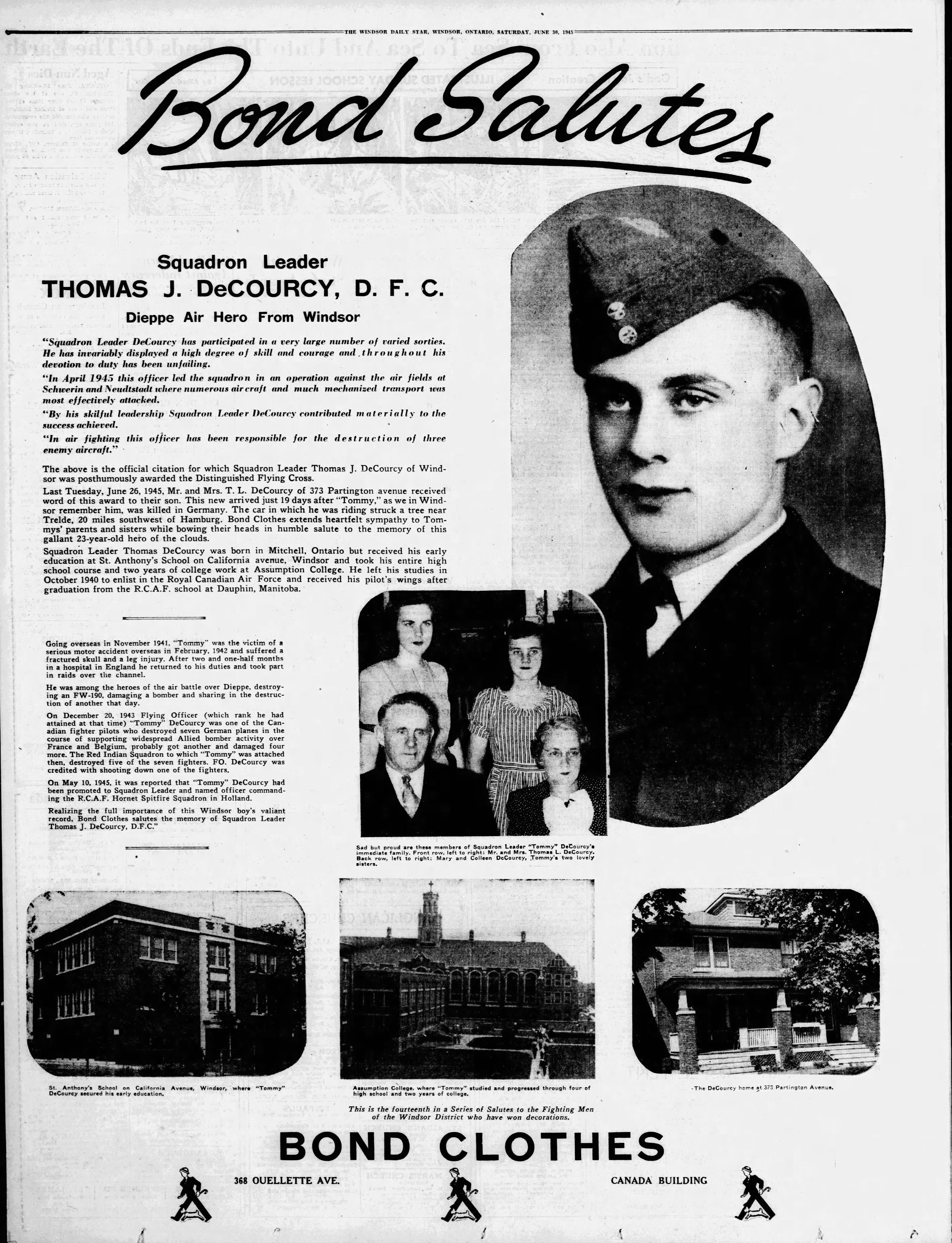
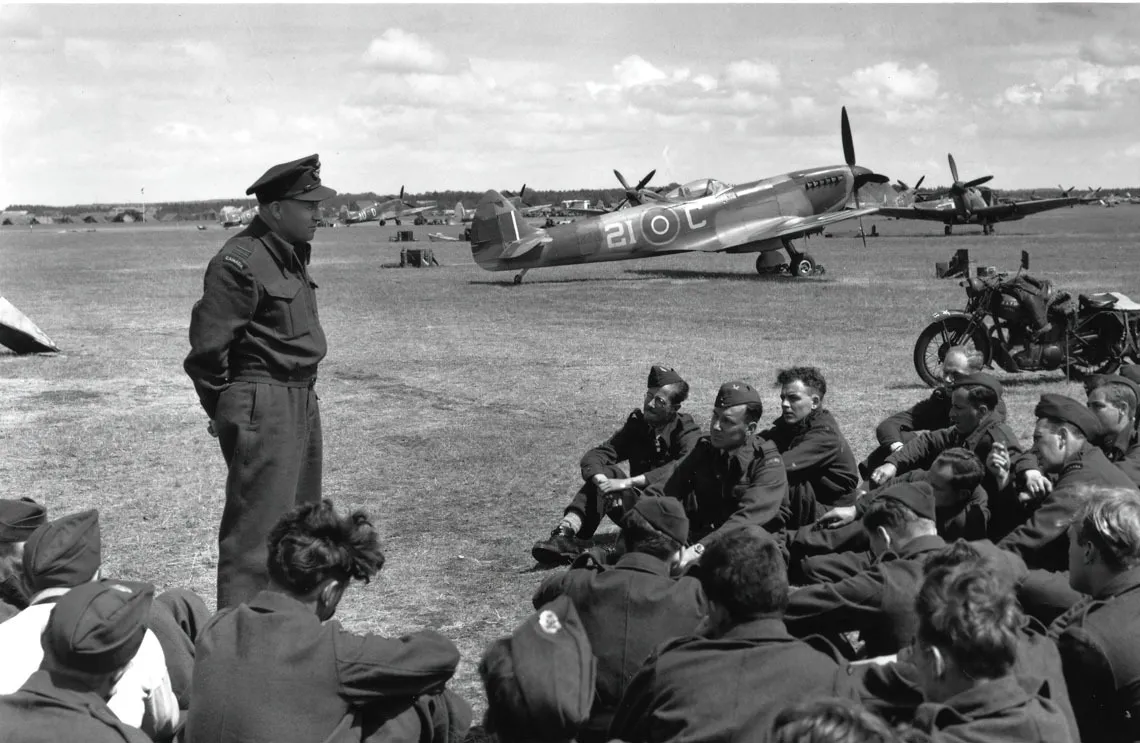
CHRIS THOMAS Flightlines Magazine Canadian Warplane Heritage Museum
Born at Mitchell, Ontario, 2 August 1921. Home in Windsor, Ontario; enlisted there 7 October 1940.
- Trained at No.2 ITS (graduated 4 June 1941)
- No.16 EFTS (graduated 27 July 1941)
- No.10 SFTS (graduated 24 October 1941)
- awarded wings on 24 October 1941.
Arrived in UK, 11 November1941. Commissioned 1942. Served 118, 421 and 443 Squadrons;20 May 1941
On May 3rd, 1945, while returning from the day's final operation, Squadron Leader DeCourcy in Spitpifre Mk. XVle TD239, shared in the destruction of a JU 88 with Flying Officer W.A. Marshall and Flight Lieutenant R.G.Sim. It would be the Squadron's last victory of the war.Flightlines Magazine Canadian Warplane Heritage Museum
Killed in automobile accident, Germany, 7 June1945: Squadron Leader DeCourcy died in car accident twenty miles south-west of Hamburg at Trelde, Germany. He had been injured in the United Kingdom on February 7, 1942.
Addendum: - Distinguished Flying Cross - No.443 Squadron (deceased) - Award effective 26 June 1945 as per London Gazette of that date and AFRO 1291/45 dated 10 August 1945. The citation reads - "Squadron Leader DeCourcy has participated in a very large number of varied sorties. He has invariably displayed a high degree of skill and courage and throughout his devotion to duty had been unfailing. In April 1945, this officer led the squadron in an operation against the airfields at Schwerin and Neudstadt where numerous aircraft and much mechanical transport were most effectively attacked. By his skillful leadership Squadron Leader DeCourcy has contributed materially to the success achieved. In air fighting this officer has been responsible for the destruction of three enemy aircraft." Detail provided by H. Halliday, Orleans, Ontario.
Supermarine Spitfire
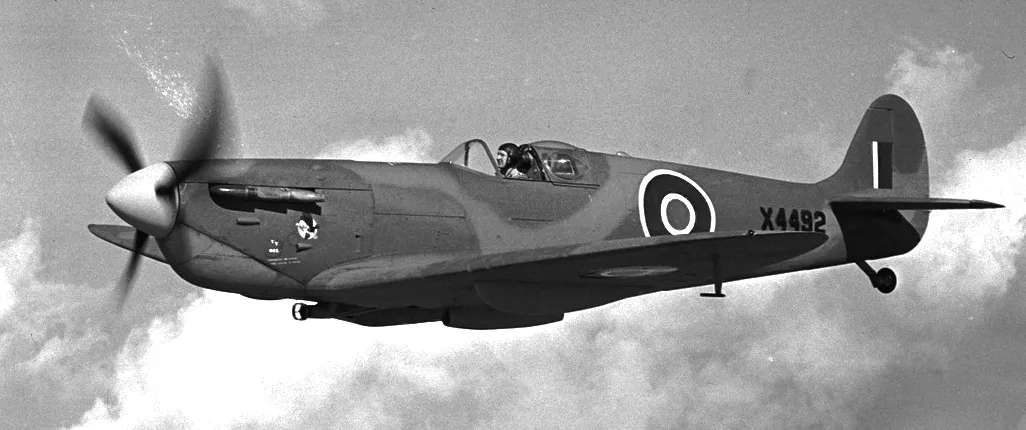
Supermarine Spitfire Mk. VI, RCAF (Serial No. X4492), in flight, 26 Feb 1944.
The Supermarine Spitfire is a British single-seat fighter aircraft that was used by the Royal Air Force and other Allied countries before, during, and after World War II. Many variants of the Spitfire were built, using several wing configurations, and it was produced in greater numbers than any other British aircraft. It was also the only British fighter produced continuously throughout the war. The Spitfire continues to be popular among enthusiasts; around 70 remain airworthy, and many more are static exhibits in aviation museums throughout the world.
The Spitfire was designed as a short-range, high-performance interceptor aircraft by R. J. Mitchell, chief designer at Supermarine Aviation Works, which operated as a subsidiary of Vickers-Armstrong from 1928. Mitchell pushed the Spitfire's distinctive elliptical wing with cutting-edge sunken rivets (designed by Beverley Shenstone) to have the thinnest possible cross-section, helping give the aircraft a higher top speed than several contemporary fighters, including the Hawker Hurricane.
The Spitfire had detachable wing tips which were secured by two mounting points at the end of each main wing assembly. When the Spitfire took on a role as a high-altitude fighter (Marks VI and VII and some early Mk VIIIs), the standard wing tips were replaced by extended, "pointed" tips which increased the wingspan from 36 ft 10 in (11.23 m) to 40 ft 2 in (12.24 m). The other wing-tip variation, used by several Spitfire variants, was the "clipped" wing; the standard wing tips were replaced by wooden fairings which reduced the span by 3 ft 6 in (1.07 m). The wing tips used spruce formers for most of the internal structure with a light alloy skin attached using brass screws.
Due to a shortage of Brownings, which had been selected as the new standard rifle calibre machine gun for the RAF in 1934, early Spitfires were fitted with only four guns, with the other four fitted later. Early tests showed that, while the guns worked perfectly on the ground and at low altitudes, they tended to freeze at high altitude, especially the outer wing guns, because the RAF's Brownings had been modified to fire from an open bolt. While this prevented overheating of the cordite used in British ammunition, it allowed cold air to flow through the barrel unhindered. Supermarine did not fix the problem until October 1938, when they added hot air ducts from the rear of the wing-mounted radiators to the guns, and bulkheads around the gunbays to trap the hot air in the wing. Red fabric patches were doped over the gun ports to protect the guns from cold, dirt, and moisture until they were fired.
The first Rolls-Royce Griffon-engined Mk XII flew in August 1942, and first flew operationally with 41 Squadron in April 1943. This mark could nudge 400 mph (640 km/h) in level flight and climb to an altitude of 33,000 ft (10,000 m) in under nine minutes. As American fighters took over the long-range escorting of USAAF daylight bombing raids, the Griffon-engined Spitfires progressively took up the tactical air superiority role, and played a major role in intercepting V-1 flying bombs, while the Merlin-engined variants (mainly the Mk IX and the Packard-engined Mk XVI) were adapted to the fighter-bomber role. Although the later Griffon-engined marks lost some of the favourable handling characteristics of their Merlin-powered predecessors, they could still outmanoeuvre their main German foes and other, later American and British-designed fighters.Wikipedia
 Wikipedia Supermarine Spitfire
Wikipedia Supermarine Spitfire
 YouTube How the Spitfire Became an Aviation Masterpiece
YouTube How the Spitfire Became an Aviation Masterpiece
 RCAF Supermarine Spitfire Serials - Kestrel Publications
RCAF Supermarine Spitfire Serials - Kestrel Publications
443 (F) Sqn Our Sting is Death ("Hornet")
History of the Squadron before and during World War II (Aircraft: Spitfires IXB, XIV, XIVE.)
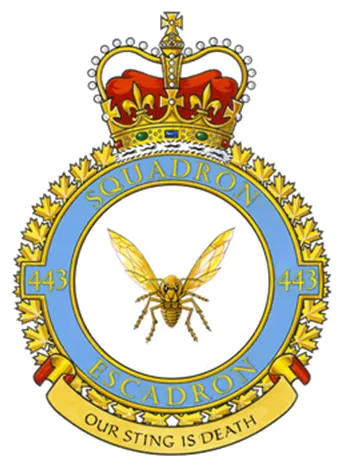
No 443 (F) Squadron was formed in Dartmouth, Nova Scotia as No. 127 (F) Squadron RCAF on January 2, 1942. It was the sixth of six home squadrons transferred overseas without its aircraft, and was re-designated No. 443 (F) Squadron RCAF at Digby, Lincolnshire, UK on February 8 1944. It flew Spitfire aircraft in offensive and defensive operations in the preparation for D-Day, and 443 Squadron, along with its sister squadrons 441 and 442, commenced flying operations with 144 (F) Wing RCAF, W/C Johnnie Johnson commanding, of the 2nd Tactical Air Force just prior to the Normandy Invasion. 144 (F) Wing RCAF was the first Allied air wing to operate from French soil. These operations continued until August 1944. The Squadron then hop-scotched across France, Belgium, and Holland with 126 and 127 (F) Wings RCAF until "VE" Day. They continued to serve with the British Occupation Forces on the cessation of hostilities in Europe, the squadron being assigned to the British Air Forces of Occupation (Germany). The squadron was disbanded at Utersen, Germany on March 21, 1946.
In the course of operations, the squadron flew 5850 sorties for the loss of 20 pilots, of whom 1 was killed, 8 presumed dead and 6 POWs. They accounted for 42 enemy aircraft confirmed destroyed, 2 probables and 29 damaged. In ground attacks they were credited with 1077 motor vehicles, 25 locomotives among other vehicles. The squadron had 1 ace: Squadron Leader H.W. McLeod, DSO, DFC and Bar. The squadron amassed 1 DSO, 6 DFCs. Battle Honours were: Fortress Europe 1944, France and Germany 1944-45, Normandy 1944, Arnhem, Rhine. Wikipedia, Kostenuk and Griffin
Maps for Movements of 443 Squadron 1944-46
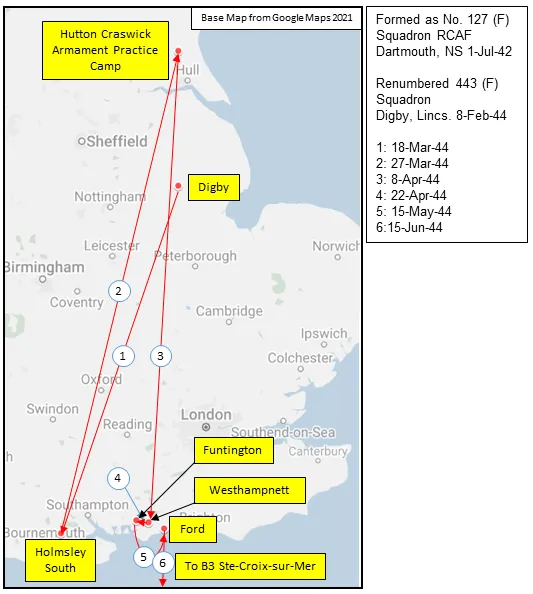 MAP 1: 443 Squadron Movements 1944-46 (right-click on image to display enlarged in new tab) | 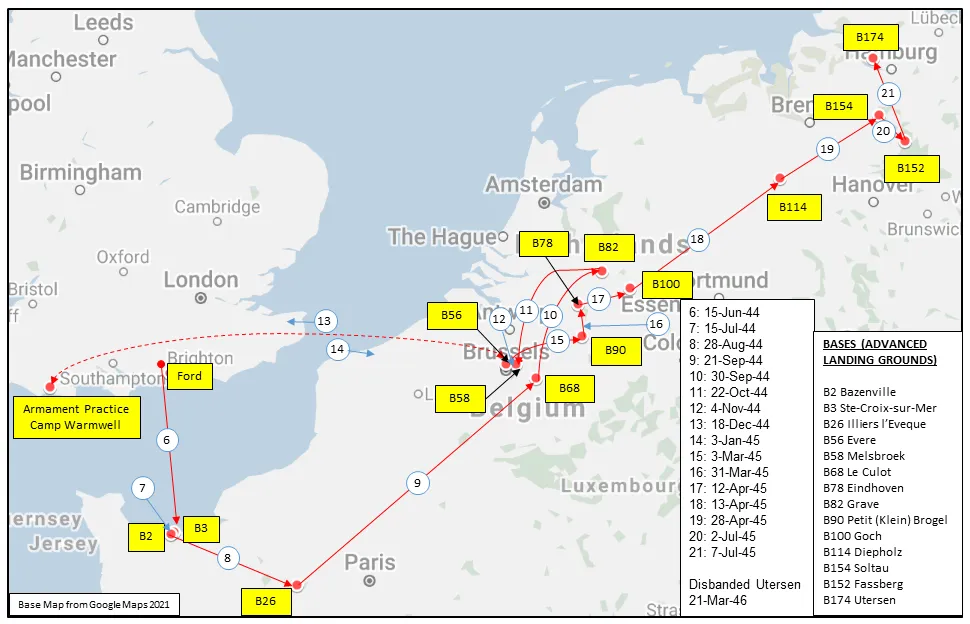 MAP 2: 443 Squadron Movements in Europe 1944-46 |
443 Squadron History Summary 1944-46
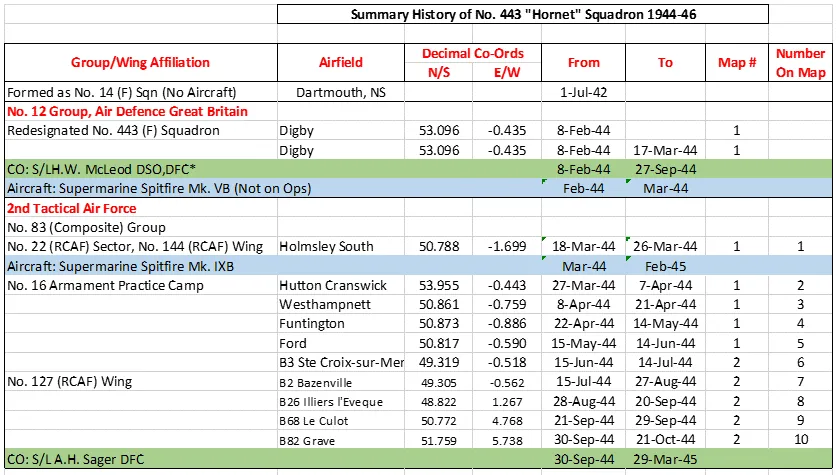
443 Squadron History Summary 1944-46 Page 2
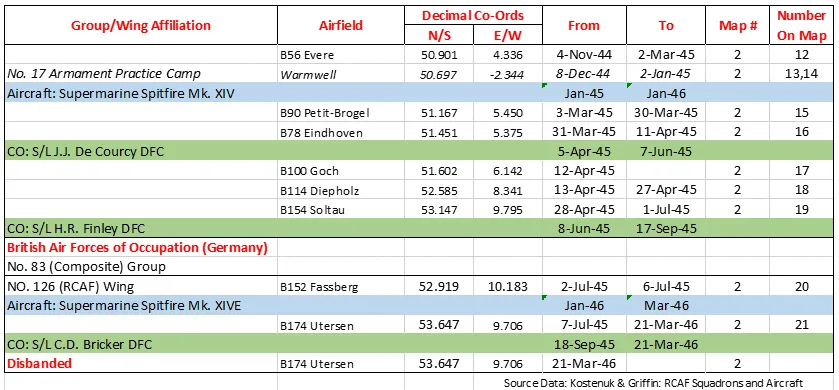
History of the Squadron Post-WWII (Aircraft: Mustang IV, Sabre 5, Expeditor, Otter, Sea King)
On 1 September 1951, the squadron was re-formed at Sea Island, Vancouver, as a Day Fighter Squadron in the RCAF Auxiliary, first flying P-51 Mustangs and eventually F-86 Sabres. In 1958, with the RCAF Auxiliary assuming the roles of Civil Defence, Search and Rescue and Light Transport, 443 (Aux) Squadron was re-equipped with the C-45 Expeditor and later the DHC-3 Otter and performed these roles until its second disbandment in March of 1964.
A decade later, in Shearwater, Nova Scotia , the Royal Canadian Navy’s only ship-borne helicopter squadron HS 50 (HS is the NATO designation for a Helicopter Anti-Submarine Squadron) was successfully meeting the needs of the Navy. However, to better administer HS 50 Squadron, it was split into HS 423 and HS 443 in September of 1974. Each squadron was tasked with continuing to provide the Commander of Maritime Command with operational Sea King Helicopter Detachments.
In response to the ever-growing need for ship-borne helicopter assets in the Pacific, HS 443 Squadron was transferred to Victoria International Airport at Pat Bay, British Columbia , in July of 1989 where it now provides the Commander of Maritime Forces Pacific with Helicopter Air Detachments. Early in 1995, HS 443 was re-designated as 443 Maritime Helicopter (MH) Squadron to better fit the ever-changing geopolitical situations and the increasingly diverse roles of maritime helicopters and the ships they support. The squadron now flies CH-145 Cyclone helicopters.
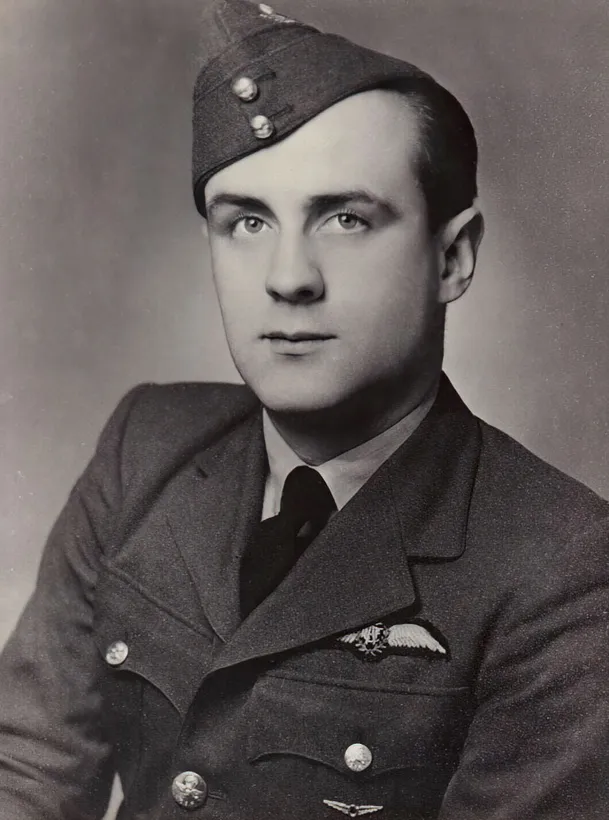

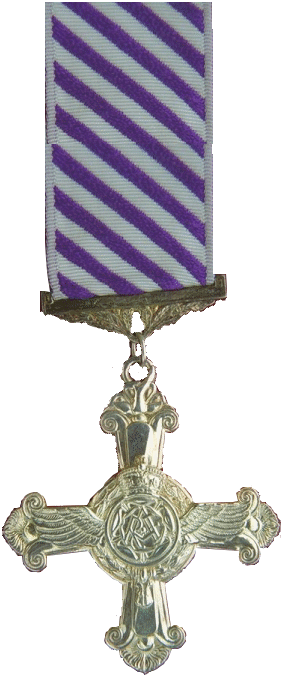
 Introducing Squadron Leader Thomas DeCourcy, DFC
Introducing Squadron Leader Thomas DeCourcy, DFC Canadian Virtual War Memorial
Canadian Virtual War Memorial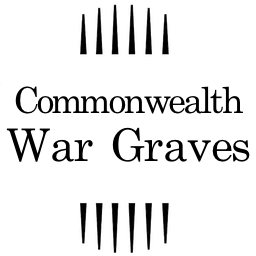 Commonwealth War Graves Commission
Commonwealth War Graves Commission www.findagrave.com
www.findagrave.com Harold A Skaarup Web Page
Harold A Skaarup Web Page